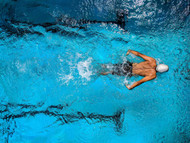Swimmer’s Shoulder Treatment
Jul 26th 2023

Swimming and water polo are amazing ways to get your body moving, and they offer something for everyone. But just like how you can fall off a cycle, injuries are possible when you're swimming or playing water polo, too. Swimmer's shoulder can mean dealing with a lot of pain and even a limited range of motion while you're swimming and even when you're out of the water.
Swimmer's shoulder, or shoulder impingement syndrome, has many treatment options, ranging from non-surgical to surgical. While painkillers might temporarily make you feel better, they're not a permanent solution. Consulting with a doctor and determining the severity of your condition is critical to getting the right treatment. Knowing how to develop swimmer's shoulder, treatment options, and how physiotherapy can help is vital to getting better.
What is Swimmer’s Shoulder?
Swimming and water polo both require continuous repetitive overhead motion while you're in the water, which can put a lot of strain on your shoulders. While swimmer’s shoulder doesn’t just begin developing because of this repetitive motion, it is the foundational source for the injury. Other factors that can lead to this injury:
- Using the incorrect technique, continuously
- Overusing muscles without resting
- Muscle imbalances and general weakness (fueled by improper diet)
- Structural swimming issues
- Lack of warm-up and cool-down, leading to muscle inflexibility
These factors can lead to tendon damage, inflammation, and impingement of the rotator cuff tendons and bursa within the shoulder joint.
How is it Diagnosed?
There are various symptoms that can warn you of getting swimmer's shoulder, and remaining alert to what they are is crucial for swimmer’s shoulder treatment later on. The symptoms can look like:
- Shoulder pain and tenderness (especially when touching it)
- Limited range of motion
- Difficulty leaning on that side, especially to sleep
- Weakness and instability
- Muscle fatigue
- Shoulder instability
Before you decide to get swimmer’s shoulder physical therapy or any other treatment, you must get diagnosed by a certified medical expert. Diagnosis will generally include a physical examination in which your pain and range of motion will be assessed. The doctor may also conduct muscle strength testing to see the extent of the injury.
Diagnostic imaging may also be used to determine the extent of the injury and the best swimmer’s shoulder treatment options for you. X-rays, MRI, and ultrasound are the three types of diagnostic imaging options that a doctor can suggest, and depending on your comfort, you can go for one that suits you. Once the diagnosis has been made, your doctor will suggest several swimmer’s shoulder treatment options, with information about the healing period and what the expected outcomes will be.
Swimmer’s Shoulder Treatment Options
There are two main ways to heal swimmer’s shoulder. The first one is to go for non-surgical methods that don’t require invasive procedures. However, if the injury is serious and does not heal through non-surgical methods, your doctor may recommend surgery for pain alleviation and healing.
The treatment for swimmer’s shoulder begins with rest and altering your daily activities. Your doctor may ask you to completely stop training and swimming and rest as much as possible. Rest can really help the healing process and ensure that your muscle recovers without further damage.
For swimmer’s shoulder, physical therapy is crucial. A skilled physiotherapist will create an individualized plan that will have a good combination of stretching and strengthening exercises to help your shoulder heal without overexertion. Swimmer’s shoulder physical therapy may also consist of manual therapy techniques, such as joint mobilization and soft tissue massages, to help with faster recovery.
For pain and inflammation, your doctor may recommend over-the-counter medication such as ibuprofen. You will need to enquire about the proper dosage to make sure that these medications don’t cause you any harm in the long term.
Heat and ice therapy, electric stimulation, and ultrasound therapy are also other viable treatment options when you’re suffering from pain and inflammation due to swimmer’s shoulder. These methods can promote tissue healing and help you get back to swimming as soon as possible.
Surgical Swimmer’s Shoulder Treatment Options
There are cases where non-surgical methods are not enough to combat the consequences of getting swimmer’s shoulder. If medication and physiotherapy do not help you regain your range of motion and shoulder stability, surgery may be the only option available.
Arthroscopic surgery is a minimally invasive procedure where small incisions are made, and a tiny camera is used to find and treat the underlying tissue. The surgeon will remove the inflamed tissue and any bone spurs during the surgery. They will also work on repairing the torn ligaments and tendons (if any) during this surgery. It will also include creating more space for the rotator cuff tendons so that the injury doesn’t happen again in the future.
After this surgery, you may also have to look into physical rehabilitation to regain your mobility. Swimmer’s shoulder physical therapy after surgery will include exercises that target the rotator cuffs and functional exercises to help you regain your swimming abilities.
When To Get Back to Swimming
Depending on the severity of your injury, swimmer’s shoulder treatment time can vary. However, you should not try to fasten this process, as doing so can cause recurring injuries without proper healing. It’s critical to learn how to prevent such injuries from happening in the first instance, and this includes learning proper form and technique while you’re swimming.
Working with a swimming instructor is ideal when you want to prevent injuries from happening. Investing in proper swimming gear, including any equipment that you might need, is essential. Ensure that you have a warm-up and cool-down routine that helps your muscles prepare before swimming and relax after you’re done.
Listening to your body is critical when you’re swimming because pushing past your limits can cause irreversible damage. Any signs of discomfort or pain should not be ignored and need to get checked by a doctor immediately. You should also go for periodic check-ups, especially if you’re doing a strenuous activity like swimming, to make sure that your body is in good condition.
When you know what a swimmer’s shoulder is, treatment options, and the recovery process, can help significantly with any injuries you get while swimming. Being informed is the first step to prevention, so take the time to educate yourself so you know what to avoid!












